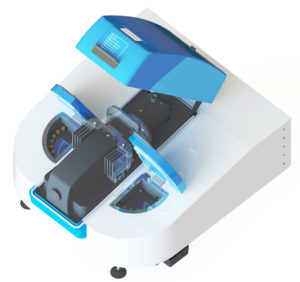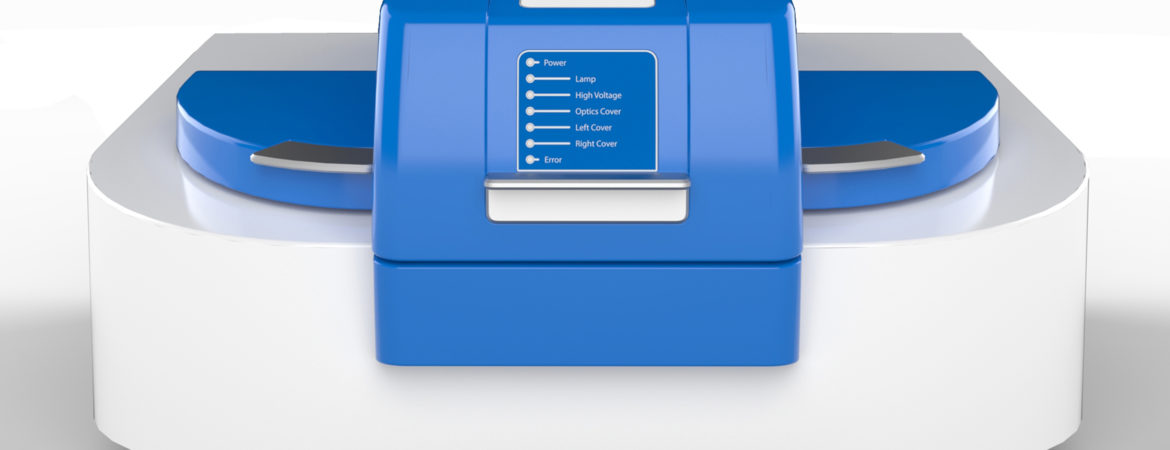deltaDOT HPCE Instruments
Our approach is quite different from conventional CE.
Through gathering data from many hundreds of points and using proprietary signal processing algorithms, our technology is able to produce better quality results than competing CE systems. deltaDOT patented multipoint detection system (512 detection points, each sampling at around 20 cycles per second) tracks the passage of biomolecule bands across the detection window.
The proprietary software derived from particle physics can determine which of the signals relate to the sample and which do not, thus eliminating any extraneous effects and inaccuracies. deltaDOT’s advanced signal processing technology combined with multi-point detection produces high quality data, i.e. sensitivity, resolution, quantification and repeatability. deltaDOT call this approach Label Free intrinsic Imaging (LFII®). The use of multipoint detection enables the analysis to be done without the need for labelling chemicals and so the technology is Label Free.
Conventional CE
Conventional Capillary Electrophoresis systems use single point detection. This means each band of biomolecules is measured by just one detector. As a result biomolecules often need to be ‘labelled’ with radiochemical, fluorescent, calorimetric, or luminescent compounds. Such CE instruments cannot differentiate between extraneous interference, electrical noise, light source fluctuations and other undesirable effects.
The Core Technology
The core science behind LFII® originated in particle physics and is now being applied by deltaDOT to biochemical analysis using Capillary Electrophoresis. The key to LFII® is the use of a multi-pixel photo diode array (PDA) and the processing of the acquired signals. This large data set is analysed by acquiring data from each band of biomolecules as it traverses each pixel at a specific time point allowing for a distance-time correlation to be achieved. The system measures the time it takes for any one band of biomolecules to traverse the detector array and the software enables the molecular weight or charge-to-mass ratio to be calculated from its velocity. This greatly improves signal-to-noise ratio offering molecular imaging which outperforms single point detection systems. The deltaDOT system only works with the signals that intersect the Vertex enabling LFII® to discriminate between system background noise, the technique known as Vertexing.
What is HPCE-512
HPCE-512 technology selling into the biomedical, biopharmaceutical and analytics markets. The company has sold nearly 30 systems so far. At its core is the proprietary Label Free Intrinsic Imaging (LFII®) approach. LFII® has significant advantages over other approaches. It has a wide spread of applications and customers in many sectors including biotech, academic, industrial and government sectors. This technology addresses the PAGE, HPLC and to some extent the Mass Spec markets.
Monoclonal Antibody Stability Trials
Monoclonal Antibody Stability (mAb) Trials Using High Performance Capillary Electrophoresis. Dr.Deepika Devanur’s presentation at the recent Proteins and Antibodies Congress. This presentation demonstrates the use of the HPCE-512 Capillary Electrophoresis platform to provide a complete characterisation of a mAb product using a single analytical tool. The use of HPCE to characterise the mAbs Rituximab and Infliximab.
HPCE-512
 Reliability and automation of deltaDOT Analytical instruments is suitable for unattended (e.g. overnight) operation which can increase productivity. deltaDOT HPCE-512’s superior performance and sensitivity obviate the need for expensive (and often toxic) chemical labels. Design ergonomics, user friendly interface and unsurpassed results in one compact bench top instrument often resulting in reducing the laboratory costs and overheads.
Reliability and automation of deltaDOT Analytical instruments is suitable for unattended (e.g. overnight) operation which can increase productivity. deltaDOT HPCE-512’s superior performance and sensitivity obviate the need for expensive (and often toxic) chemical labels. Design ergonomics, user friendly interface and unsurpassed results in one compact bench top instrument often resulting in reducing the laboratory costs and overheads.

